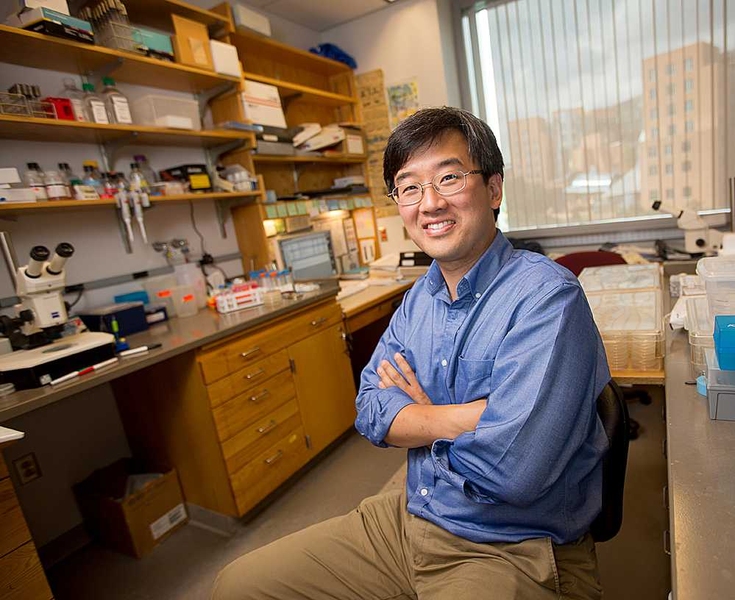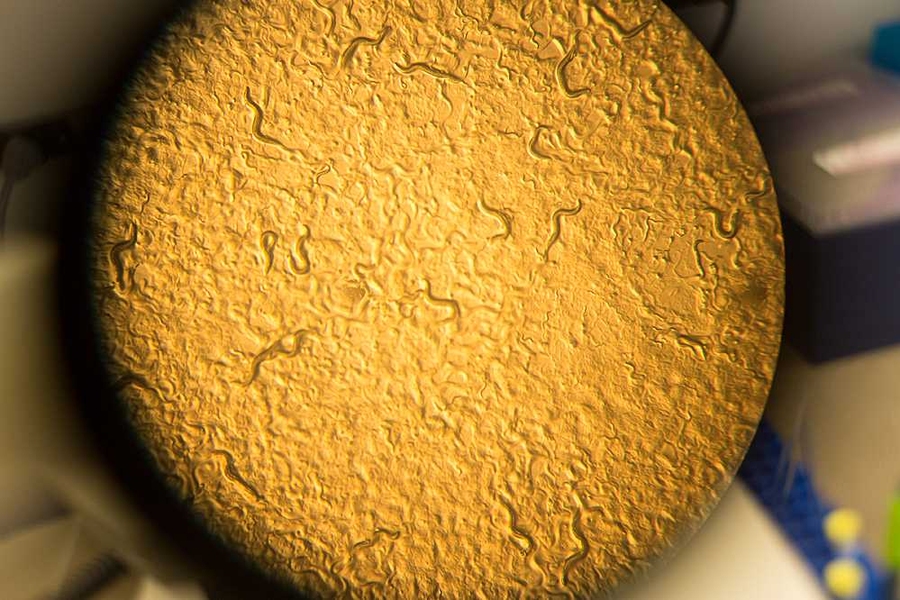In 1998, scientists published the first complete genome of a multicellular organism — the worm Caenorhabditis elegans. At the same time, new technologies were emerging to help researchers manipulate genes and learn more about their functions.
Around that time, Dennis Kim was looking for a new research project to do during his upcoming postdoctoral fellowship at Massachusetts General Hospital (MGH). He decided to try to take advantage of the new genetic tools for studying C. elegans. In particular, he wanted to delve into what’s called the “innate immune system” — the first line of defense against invaders such as viruses and bacteria.
“It was a jump into a new area for me. We had no idea what we would find,” says Kim, who is now an associate professor of biology at MIT. “By studying worms we can take a much more basic evolutionary perspective on the function of the innate immune system. We think we can learn very basic principles in a simpler host organism and also gain some perspective on the evolution of the mammalian system as well.”
The innate, or nonspecific, immune system evolved very early on in primitive animals including worms and fruit flies. Vertebrate animals, which evolved later, also have a specific immune system, which targets pathogens very precisely with antibodies, killer T cells and other cells.
In vertebrates, the innate immune system identifies pathogens and serves as an early alert system, mobilizing the immune system to launch a more specific reaction. In worms, the innate system is the only defense.
In Kim’s studies of the C. elegans immune system, he chose to investigate how the worm defends itself against Pseudomonas aeruginosa, a bacterium that commonly infects people with suppressed immune systems. He has since identified many genes necessary for innate immunity, most of which are involved in signaling between the cells involved in the immune response.
“A lot of serendipity came into play, as seems to always happen in science,” Kim says. “We were able to find some genes in the worm that are required to protect the worm against pathogenic bacteria. Those genes turned out to be genes also required in humans and mice for innate immune defense.”
Science and medicine
Kim, the son of Korean immigrants, was born in Des Moines, Iowa. When he was 10, his family moved to Covina, Calif., a small city east of Los Angeles. His parents always encouraged him to “find something you love to do.” In high school, Kim was drawn to math, which he continued studying at the University of California at Berkeley while majoring in biophysics.
The summer after his sophomore year, Kim got a job working in a chemistry lab studying the biophysics of photosynthesis. One of his duties was going to the grocery store for bunches of spinach to grind up so the photosynthetic enzymes could be purified. The fresher the spinach, the better the results. “I became the most discriminating buyer of spinach you’ve ever seen,” he says.
During that summer, Kim became absorbed in studying how plants use sunlight to split water to make the oxygen we breathe, and got hooked on doing lab research. Most likely he would have continued studying biophysics exclusively, he says, if not for an accident that occurred after his junior year: While riding his motor scooter near Berkeley, he was hit by a car, fracturing his leg.
Kim spent several months rehabbing the leg, unable to attend his classes. During this time, he was fascinated by how well his doctors were able to heal his injury. “I was really impressed with that. I had no inkling of going to medical school at that time, but through that experience, human health came back into my sphere of thinking,” he says.
After graduating from Berkeley, Kim decided to pursue an MD/PhD at Harvard Medical School. For his PhD in biological chemistry, he studied enzymes involved in bacterial cell-wall synthesis, which are the targets of major classes of antibiotics. After earning his MD, he did an internship and residency in internal medicine at Brigham and Women’s Hospital (BWH) and a fellowship in infectious disease at MGH and BWH.
Although Kim now focuses mainly on lab research and teaching, he still sees patients at MGH. “I just really have always enjoyed trying to take care of sick people,” he says.
Complex interactions
Since arriving at MIT in 2005, Kim has expanded his research to focus on interactions between bacteria and C. elegans and how those interactions influence the worms’ behavior, stress physiology and aging.
For example, worms that eat harmful bacteria will then avoid that type of bacteria. Kim is looking for receptors in worm cells that interact with the molecules produced by the bacteria and trying to identify the genes and molecules involved in the resulting behavioral responses.
Many of the signaling pathways that appear to be involved in these behavioral responses are also found in humans, so Kim believes these studies could also shed light on the physiology of humans — whose bodies contain 10 times more bacterial cells than human cells. “It’s increasingly clear things we do to alter our microbial flora can have a pretty pronounced influence on our physiology,” he says.
Around that time, Dennis Kim was looking for a new research project to do during his upcoming postdoctoral fellowship at Massachusetts General Hospital (MGH). He decided to try to take advantage of the new genetic tools for studying C. elegans. In particular, he wanted to delve into what’s called the “innate immune system” — the first line of defense against invaders such as viruses and bacteria.
“It was a jump into a new area for me. We had no idea what we would find,” says Kim, who is now an associate professor of biology at MIT. “By studying worms we can take a much more basic evolutionary perspective on the function of the innate immune system. We think we can learn very basic principles in a simpler host organism and also gain some perspective on the evolution of the mammalian system as well.”
The innate, or nonspecific, immune system evolved very early on in primitive animals including worms and fruit flies. Vertebrate animals, which evolved later, also have a specific immune system, which targets pathogens very precisely with antibodies, killer T cells and other cells.
In vertebrates, the innate immune system identifies pathogens and serves as an early alert system, mobilizing the immune system to launch a more specific reaction. In worms, the innate system is the only defense.
In Kim’s studies of the C. elegans immune system, he chose to investigate how the worm defends itself against Pseudomonas aeruginosa, a bacterium that commonly infects people with suppressed immune systems. He has since identified many genes necessary for innate immunity, most of which are involved in signaling between the cells involved in the immune response.
“A lot of serendipity came into play, as seems to always happen in science,” Kim says. “We were able to find some genes in the worm that are required to protect the worm against pathogenic bacteria. Those genes turned out to be genes also required in humans and mice for innate immune defense.”
Science and medicine
Kim, the son of Korean immigrants, was born in Des Moines, Iowa. When he was 10, his family moved to Covina, Calif., a small city east of Los Angeles. His parents always encouraged him to “find something you love to do.” In high school, Kim was drawn to math, which he continued studying at the University of California at Berkeley while majoring in biophysics.
The summer after his sophomore year, Kim got a job working in a chemistry lab studying the biophysics of photosynthesis. One of his duties was going to the grocery store for bunches of spinach to grind up so the photosynthetic enzymes could be purified. The fresher the spinach, the better the results. “I became the most discriminating buyer of spinach you’ve ever seen,” he says.
During that summer, Kim became absorbed in studying how plants use sunlight to split water to make the oxygen we breathe, and got hooked on doing lab research. Most likely he would have continued studying biophysics exclusively, he says, if not for an accident that occurred after his junior year: While riding his motor scooter near Berkeley, he was hit by a car, fracturing his leg.
Kim spent several months rehabbing the leg, unable to attend his classes. During this time, he was fascinated by how well his doctors were able to heal his injury. “I was really impressed with that. I had no inkling of going to medical school at that time, but through that experience, human health came back into my sphere of thinking,” he says.
After graduating from Berkeley, Kim decided to pursue an MD/PhD at Harvard Medical School. For his PhD in biological chemistry, he studied enzymes involved in bacterial cell-wall synthesis, which are the targets of major classes of antibiotics. After earning his MD, he did an internship and residency in internal medicine at Brigham and Women’s Hospital (BWH) and a fellowship in infectious disease at MGH and BWH.
Although Kim now focuses mainly on lab research and teaching, he still sees patients at MGH. “I just really have always enjoyed trying to take care of sick people,” he says.
Complex interactions
Since arriving at MIT in 2005, Kim has expanded his research to focus on interactions between bacteria and C. elegans and how those interactions influence the worms’ behavior, stress physiology and aging.
For example, worms that eat harmful bacteria will then avoid that type of bacteria. Kim is looking for receptors in worm cells that interact with the molecules produced by the bacteria and trying to identify the genes and molecules involved in the resulting behavioral responses.
Many of the signaling pathways that appear to be involved in these behavioral responses are also found in humans, so Kim believes these studies could also shed light on the physiology of humans — whose bodies contain 10 times more bacterial cells than human cells. “It’s increasingly clear things we do to alter our microbial flora can have a pretty pronounced influence on our physiology,” he says.







